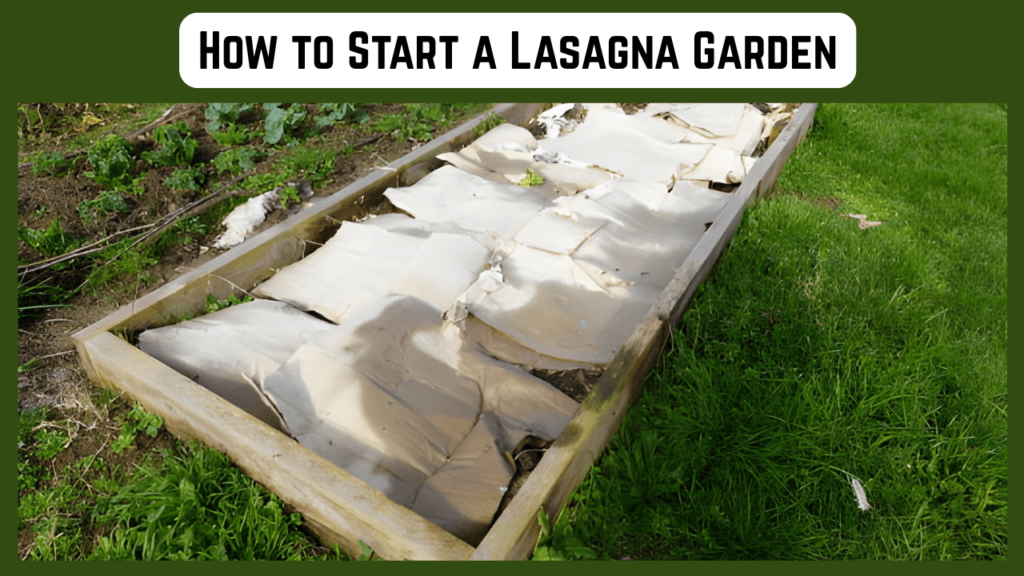
How many times you have wished that there was an easier way to garden — with no weeding, digging, or tilling required — and no of the same old endless back-breaking work?
Well, welcome to the wonderful world of lasagna gardening — a method that is so easy which almost feels like cheating.
Don’t worry — you’re not actually growing lasagna! The name comes from the layered technique, which resembles how you stack noodles, sauce, and cheese in an Italian lasagna.
Except here, you’re layering organic materials like cardboard, leaves, grass clippings, and compost. Over time, these layers break down naturally, turning into rich, dark, crumbly soil that plants absolutely love.
I’ll never forget my first lasagna bed — constructed on a worn strip of forlorn weedy grass behind my house.. I stacked cardboard, old leaves, and a few kitchen scraps, watered it, and left it to “cook.” By spring, I had soil so rich and soft that my shovel slid in like butter. That’s when I realized: Mother Nature knows best.
🌱 What Is Lasagna Gardening ?
Lasagna gardening — also called sheet composting — is a no-dig, no-till gardening method that builds healthy soil right on top of the ground.
Instead of disturbing your soil structure (like traditional digging does), you simply create layers of organic materials that compost in place. These layers attract worms, microbes, and beneficial bacteria — nature’s own garden crew — who do the hard work for you.
Think of it as making compost directly in your garden bed. It’s easy, eco-friendly, and surprisingly fast once it starts breaking down.
It’s like building a composter directly in your garden bed. It’s quick, environmentally aware and even faster once it starts breaking down.
🌻 Why Try Lasagna Gardening ?
Here’s why gardeners everywhere are falling in love with this method:
1. No Digging Required
Forget about breaking your back with a shovel. Just lay them down, water them and let nature take it from there. It’s all new-gardener friendly, or for anyone who doesn’t want to fuss over composting and soil prep.
2. Fewer Weeds
The bottom layer is most usually made of cardboard or newspaper — blocks sunlight, smothering weeds before they can even sprout. You’ll spend more time admiring your plants and less time pulling invaders.
3. Healthy, Fertile Soil
As the layers will decompose, they release nutrients that feed your plants all season long. You won’t need to rely heavily on the fertilizers or chemical amendments.
4. Better Water Retention
The spongy layers trap moisture, keeping roots hydrated longer — especially useful if you live in a hot or dry region.
5. Eco-Friendly and Sustainable
You’re turning everyday waste — like kitchen scraps, leaves, and paper — into valuable soil. It’s recycling at its best.
🌾 What You’ll Need
Gather your ingredients before you begin — in fact, just like making a real lasagna!
🟤 Brown Materials (Carbon-Rich)
These “dry” layers provide structure and help air circulate. Examples include:
- Shredded dry leaves
- Newspaper or cardboard (non-glossy, biodegradable)
- Straw or hay
- Pine needles
- Wood chips or sawdust (in moderation)
🟢 Green Materials (Nitrogen-Rich)
These are your “wet” ingredients — they decompose quickly and give your plants nitrogen:
- Grass clippings
- Vegetable peels and fruit scraps
- Coffee grounds and tea leaves
- Garden trimmings
- Manure from herbivores (cow, horse, rabbit, or goat)
You can also sprinkle in a little peat moss or finished compost between layers — this helps the decomposition process along nicely.
🌿 Step-by-Step: How to Build a Lasagna Garden
Step 1: Pick the Perfect Spot
Choose a sunny area where your plants will thrive. There’s no need to strip grass or clear weeds — just build right on top.
Step 2: Lay the Foundation
Start with cardboard or newspaper directly on the ground. Overlap the sheets so no sunlight sneaks through. This layer does two things: It retards weeds, and encourages earthworms to come up by simply hacking their way through as it decays. Soak it well with a hose — it should be damp but not soggy.
Step 3: Add Your Layers
Now, begin layering your greens and browns as if you are building a compost lasagna:
- Add a 2–3 inch layer of green material (like kitchen scraps or grass clippings).
- Cover it with 5–6 inches of brown material (dried leaves or straw).
- Repeat until your pile is about 2 feet high. It’ll shrink as it decomposes.
Remember: the goal isn’t perfection. You don’t need to measure every layer — just aim for roughly twice as much brown as green.
Step 4: Water as You Go
After each layer, give it a gentle watering. Moisture helps the microbes get to work faster, but too much water can drown them — so think “damp sponge,” not “mud pit.”
Step 5: Let It Cook
Now, here’s where the magic happens. Over the next few months, your lasagna bed will start to “cook” — the layers heat up, break down, and transform into dark, rich soil. If you start in the fall, it’ll be ready by the spring.
If you begin the soil structure project of your dreams in spring, add a bit of compost or soil on top so that you can plant right away.
Step 6: Plant and Enjoy
Once the layers settle, plant your favorite vegetables, herbs, or flowers directly into the new soil. Tomatoes, cucumbers, beans, and leafy greens love this setup.
💡 Lasagna Gardening Ideas
Once you’ve mastered the basics, there’s no limit to how creative you can get! Here are some inspiring ideas:
- Lasagna garden in raised beds: Build layers inside a wooden or metal raised bed for a neat, contained look.
- Container lasagna gardening: No room? Do it in large tubs or barrels.
- Themed gardens: Create a “pizza garden” with tomatoes, basil, and peppers — all planted in your lasagna layers.
- Lasagna flower beds: Mix colorful blooms like marigolds, zinnias, and cosmos for a vibrant no-dig flower patch.
- Urban lasagna gardens: Use cardboard, compost, and old potting soil to turn an unused corner or balcony into a mini eco-paradise.
🌻 Pros and Cons of Lasagna Gardening
Like any gardening method, lasagna gardening has its ups and downs. Here’s what to keep in mind:
✅ Pros
- No digging or tilling: Say goodbye to sore backs and blisters.
- Weed control: That cardboard base keeps most weeds from popping up.
- Improves soil health: Creates soft, rich, well-aerated soil full of life.
- Eco-friendly: Reuses kitchen and yard waste that would otherwise go to landfill.
- Low cost: You can build it entirely from free as we make it from the natural materials.
⚠️ Cons
- Takes time to decompose: You might have to wait a few months before planting directly.
- Needs lots of materials: Collecting enough browns and greens can be a chore.
- Can dry out quickly: This is particularly a risk in hotter, sunnier climates — you’ll need to water often.
- May attract pests: If you add the wrong scraps (like meat or dairy), you could invite unwanted visitors.
🌾 A Personal Take: Why Lasagna Gardening Works
I started my first lasagna garden a few years ago on a patch of rock-hard clay soil that nothing seemed to grow in. I didn’t have the tools or energy to till it, so I laid down cardboard, piled up kitchen scraps, leaves, and old straw — and forgot about it over winter.
By spring, it had transformed into rich, crumbly soil full of earthworms. The first plants I grew — tomatoes and zucchini — were the healthiest I’d ever had.
That’s when I knew: I had tapped into an art of gardening so easy that it ranks as nature’s way of rewarding patience and creativity.
🐛 Caring for Your Lasagna Garden
- Add mulch on top to keep moisture in and prevent weeds.
- Replenish every year with a handful of new layers of leaves, compost or straw.
- Do not put meat, dairy or greasy foods in there — they attract pests.
- Turn or fluff layers occasionally if decomposition slows down.
Once they’re established, maintenance is about as minimal as you can get. Your lasagna garden will practically feed itself — and you’ll be harvesting from soil that just gets better and better each year.
🌼 Lasagna Gardening for Beginners
If you are a beginner gardener, lasagna gardening is hands-down one of the simplest ways to begin. You don’t need fancy tools or a rototiller or even perfect soil — you can literally start over a patch of grass, over an area covered with gravel, or even over weeds.
You only need layers of organic matter and a little patience.
Here’s the secret: the “recipe” for a great lasagna garden isn’t strict. You can build it with whatever organic waste you have on hand — old newspapers, grass clippings, kitchen scraps, or dry leaves. As long as you balance your layers, nature will take care of the rest.
🌼 When to Start Lasagna Gardening
The best time to start is in autumn, when leaves and organic materials are plentiful. The winter rains help everything settle and compost naturally, leaving you with ready-to-plant soil in spring.
But if you’re starting it in the spring or summer, don’t worry — top it off with some compost or soil so that you can start planting right away, while the rest of the layers decompose underneath.
🌿 FAQs About Lasagna Gardening
1. Can I build a lasagna garden on grass or weeds?
Absolutely! Just lay down cardboard or newspaper first to smother them. They’ll decompose right along with the rest of the materials.
2. How long before I can plant?
If you start in fall, it’s usually ready by spring. For spring setups, add a few inches of compost or soil on top to start planting right away.
3. Does it attract pests?
If you avoid meat, dairy, and oily food scraps — no. The decomposition process actually discourages most pests.
4. Do I need special compost?
Nope! Everyday kitchen and yard waste works perfectly. Just keep your layers balanced and moist.
5. What if I don’t have enough materials?
No worries — start small. A few layers will enrich your soil. It’s something you can continue to add on to over the years.
🌻 Final Thoughts: Build Your Garden the Lazy Way
Lasagna gardening is that proof that great gardens don’t have to start with hard labor. Whether you are a busy parent, or an eco-conscious grower, or someone new to the gardening, this method will give you a healthier soil, better harvests, and far less work.
Next time you see a pile of leaves or kitchen scraps, don’t toss them — layer them! In a few months, you’ll be rewarded with rich, living soil that practically grows dreams.

